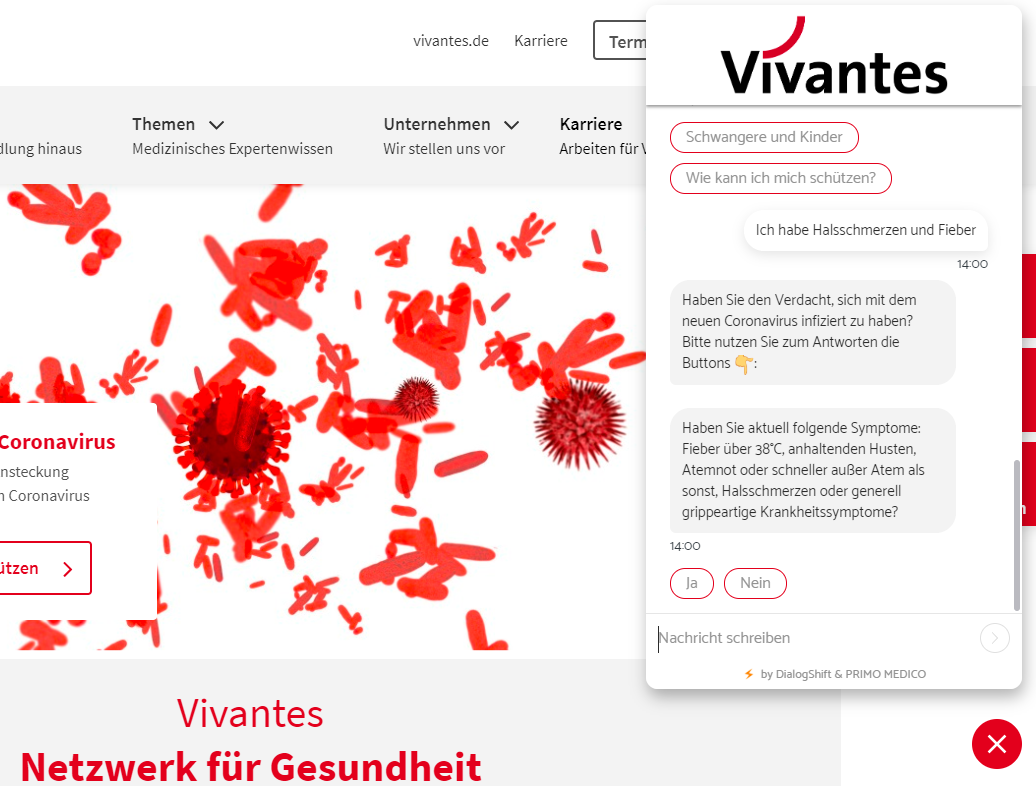Chatbots: Startup DialogShift relieves Corona Hotline of the Vivantes Clinic
Is this another cold or already Corona? Many Berliners asked themselves this question, especially in early March. No wonder that the hotlines at the Vivantes Klinikum ran hot. The uncertainty was enormous. The personnel could hardly follow the many inquiries. A solution was needed. Within shortest time the hospital management decided therefore to go an unusual way. They introduced a chatbot, got the Berlin startup DialogShift on board and wrote a unique success story. We asked DialogShift founder and CEO Olga Heuser how the cooperation went.

Olga, with the topic Chatbots the ghosts divide themselves, how does your Skeptiker convince?
Not at all! Who does not see the increase in value, is simply not yet so far. Chatbots were gehypt in the past years and again banished. In the meantime, however, the technology has become much more mature and has gained acceptance in customer service because it simply means an enormous relief for many companies.
What do the chats of today do?
Chat bots help best when they are focused on a specific topic or task. One example is the chatbot we created for the Vivantes Clinic. The goal was not at all to create a chatbot that answers all questions. Who needs that when you have Google? Instead, the aim was to provide easily accessible answers to the 30 questions that are otherwise most frequently asked on the hospital’s Corona hotline.
How was the chatbot accepted by the users?
For Vivantes it was a huge relief. We automated questions such as “Where can I get tested for Corona?”, “Do I need an appointment for the test center?”, “I have a cough and a cold – do I need to get tested?”, in other words, everything that revolved around symptoms and test centers. Later, many questions about the maternity clinics were added. Shortly after going live, the bot already answered 1000 questions a day. That is otherwise 1000 five-minute telephone calls for the employees. Of course there will always be people who prefer personal contact. And there are situations in which the chatbot cannot help. In this case it is important to make people available.
You make sure that it is transparently visible that one is communicating with a chatbot. This was not always a matter of course in the industry, was it?
Yes, in 2018 it was actually 2018 to create chat bots where you didn’t know for sure: Is this a human or a machine? But then there were some user experience studies that clearly showed that the user experience is better if it is kept transparent. The Chatbot is then also less critically seen and if the Chatbot does not know further, the users are more forgiving.
On your website it looks like you are specialized in hotels. How did you start working with Vivantes?
That’s right. We primarily create chat solutions for hotels or for the communication between hotels and their guests, starting with the website, the guest app, Whatsapp and Facebook messenger. But the use cases are similar to Vivantes. The point is that the most common questions a guest has, such as “Do you have a parking space?”, “Can I bring my dog?” and “Can I have my laundry washed at your place? The chatbot then gives the guests more information and tips. It tells them more or less how cool the hotel is. And you can book your stay directly from the chat. Our application is the most mature one for this market. Basically, however, our product is industry diagnostic. That’s why we were able to react so quickly in March when the Vivantes Clinic needed support. The clinic decided in favor of us within a few days and within a week our bot went live.
How did you as a start-up at Vivantes get your foot in the door?
We succeeded thanks to our partner Primo Medico – a Munich-based company that offers other services for clinics and doctors. Our colleagues established contact and supported us and we set up the chatbot.
What was the biggest challenge in this cooperation project?
One challenge was that we had no training data for our artificial intelligence. When you set up a bot on a new topic, you have to train it with questions and data. But we didn’t have enough data on Corona at that time. We just entered the basics, went live with the bot and trained everything over the next few weeks. The hotlines at Vivantes were totally overloaded at that time because so many people called. So it was all about making the service available as quickly as possible. So we got better and better every day. What was especially nice was that the cooperation with Vivantes worked incredibly well. The team provided great input and reacted very quickly.
Olga, what do you think: What does the future of chatbots look like?
In the future we will have “conversational experiences” in many places in our everyday life, that means talking to chatbots or language assistants – when ordering in the coffee store, at the reception or at the ski lift. Because there is one thing bots are really good at: answering recurring questions and simple processes.
Contact
Website: www.dialogshift.com/en
LinkedIn: https://www.linkedin.com/in/olga-heuser
About Ambivation

Ambivation connects innovative companies and startups for cooperation and innovation partnerships. As an innovation consultancy and matchmaker, Ambivation promotes cooperation between established companies and startups within the framework of concrete customer, supplier and research partnerships. We support companies in the identification of needs, startup identification, startup evaluation and cooperation initiation with startups. Formats such as research on relevant startups, startup monitoring, strategic cooperation consulting or event formats such as startup tours serve this purpose. Our monthly newsletter also provides information on current examples of cooperation and events.





